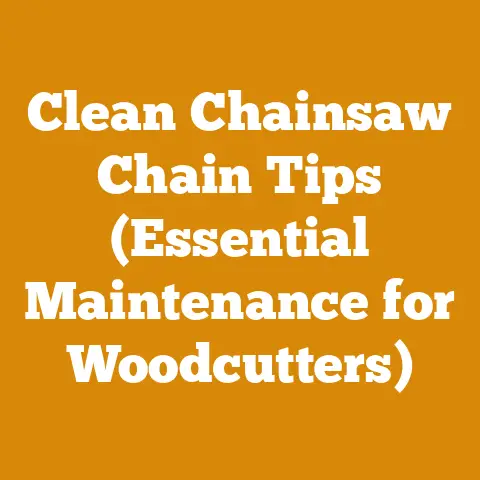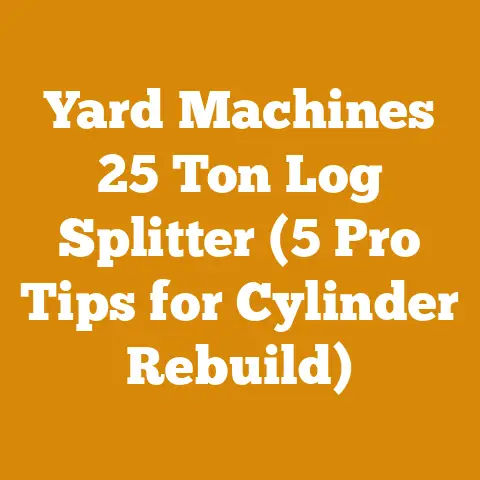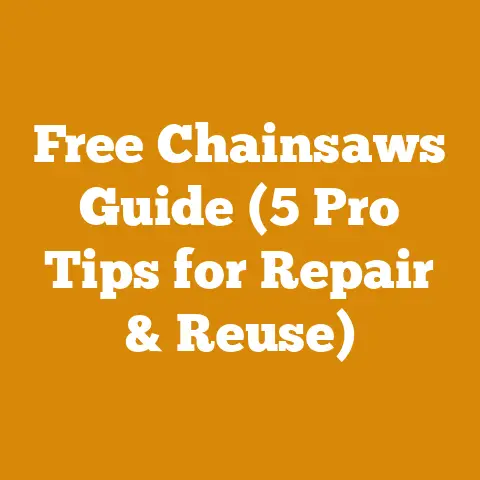Stump Grinder and Trailer: Tilt vs Enclosed (Pro Setup Tips)
Let’s cut to the chase: Choosing the right trailer for your stump grinder can make or break your efficiency and profitability. Whether you opt for a tilt trailer or an enclosed trailer, each has its pros and cons. I’ve spent years hauling equipment through muddy logging roads and tight urban streets, and I’m here to share my hands-on experience to help you make the best decision. This isn’t just about hauling; it’s about protecting your investment, streamlining your operations, and ensuring you’re set up for success.
Stump Grinder and Trailer: Tilt vs. Enclosed (Pro Setup Tips)
When you’re running a stump grinding business, or even just tackling large-scale land clearing projects, the right equipment setup is critical. A stump grinder is a powerful tool, but it’s only as effective as your ability to transport it safely and efficiently. That’s where the trailer comes in. The debate between a tilt trailer and an enclosed trailer isn’t just about preference; it’s about matching the right tool to the right job and understanding the long-term implications for your business.
Understanding the Stakes: Why the Right Trailer Matters
Before we dive into the specifics, let’s understand why this decision is so crucial.
- Efficiency: A well-chosen trailer streamlines your workflow, reducing loading and unloading times.
- Safety: Proper transport minimizes the risk of damage to your equipment and ensures the safety of you and others on the road.
- Protection: An enclosed trailer safeguards your stump grinder from the elements and potential theft.
- Professionalism: The right setup enhances your professional image, instilling confidence in your clients.
- Longevity: Protecting your equipment extends its lifespan, reducing maintenance costs and maximizing your return on investment.
Tilt Trailer: The Workhorse
A tilt trailer, also known as a tilt-bed trailer, is designed with a deck that pivots, allowing for easy loading and unloading of equipment. The tilt mechanism is usually hydraulically assisted, making the process smooth and effortless.
Advantages of a Tilt Trailer
- Ease of Loading and Unloading: The primary advantage of a tilt trailer is the ease with which you can load and unload your stump grinder. The tilting deck eliminates the need for ramps, making the process quick and straightforward.
- Speed and Efficiency: Because of the simplified loading process, you can save valuable time on each job site. Time is money, especially when you’re running a business.
- Lower Initial Cost: Tilt trailers generally have a lower purchase price compared to enclosed trailers. This can be a significant factor for those just starting out or on a tight budget.
- Versatility: Tilt trailers aren’t just for stump grinders. They can be used to haul a variety of equipment, from ATVs and mowers to small tractors.
- Maintenance Simplicity: With fewer moving parts than an enclosed trailer, tilt trailers typically require less maintenance.
Disadvantages of a Tilt Trailer
- Exposure to the Elements: Your stump grinder is fully exposed to the elements, including rain, snow, and sun. This can lead to rust, corrosion, and premature wear.
- Security Concerns: Without any enclosure, your equipment is vulnerable to theft. You’ll need to invest in robust security measures like locks and GPS tracking.
- Limited Storage: Tilt trailers offer no additional storage space for tools, spare parts, or personal items.
- Road Salt Corrosion: Especially in regions with harsh winters, road salt can wreak havoc on your equipment. The constant exposure accelerates corrosion, leading to costly repairs.
Real-World Example
I remember one particularly wet spring when I was using a tilt trailer to haul my stump grinder. I arrived at a job site only to find that the rain had seeped into the engine, causing it to sputter and stall. I lost valuable time drying it out and getting it running again. That experience taught me the importance of protecting my equipment from the elements.
Data Point
According to a study by the National Association of Trailer Manufacturers (NATM), trailers exposed to harsh weather conditions require 30% more maintenance on average compared to those stored indoors or enclosed.
Enclosed Trailer: The Fortress
An enclosed trailer is essentially a mobile garage, providing a secure and weatherproof environment for your stump grinder. These trailers come in various sizes and configurations, offering ample storage space and protection from the elements.
Advantages of an Enclosed Trailer
- Superior Protection: The enclosed design shields your stump grinder from rain, snow, sun, and road debris, extending its lifespan and reducing maintenance costs.
- Enhanced Security: Enclosed trailers offer a high level of security, deterring theft and vandalism.
- Ample Storage Space: You can store tools, spare parts, safety gear, and other essentials inside the trailer, keeping everything organized and readily accessible.
- Professional Image: An enclosed trailer projects a professional image, signaling to your clients that you take your business seriously.
- Customization Options: Enclosed trailers can be customized with shelving, lighting, workbenches, and other features to suit your specific needs.
Disadvantages of an Enclosed Trailer
- Higher Initial Cost: Enclosed trailers are significantly more expensive than tilt trailers. This can be a barrier to entry for some businesses.
- Increased Weight: The added weight of the enclosure reduces fuel efficiency and may require a more powerful tow vehicle.
- Maneuverability Challenges: Enclosed trailers can be more difficult to maneuver in tight spaces, especially in urban environments.
- Loading and Unloading Complexity: Loading and unloading a stump grinder into an enclosed trailer typically requires ramps or a lift gate, which can be more time-consuming than tilting a trailer.
- Maintenance Complexity: Enclosed trailers have more components, such as doors, windows, and electrical systems, which can require more maintenance.
Real-World Example
I once had a client who insisted on storing his stump grinder in his backyard. Over the winter, the engine froze, the tires cracked, and the electrical system corroded. By the time spring rolled around, the machine was inoperable and required extensive repairs. If he had stored it in an enclosed trailer, he could have avoided those costly problems.
Data Point
A survey conducted by the Associated Equipment Distributors (AED) found that equipment stored in enclosed trailers experiences 20% less downtime due to weather-related issues compared to equipment stored outdoors.
Deep Dive: Key Considerations for Your Stump Grinder Trailer
Before making a decision, let’s examine some key factors that will influence your choice.
Stump Grinder Size and Weight
The size and weight of your stump grinder are critical factors in determining the appropriate trailer. You’ll need to ensure that the trailer has a sufficient weight capacity and deck size to accommodate your equipment.
- Weight Capacity: Check the gross vehicle weight rating (GVWR) of the trailer and make sure it exceeds the combined weight of your stump grinder, tools, and any other cargo you plan to carry.
- Deck Size: Measure the length and width of your stump grinder and ensure that it will fit comfortably on the trailer deck. Allow for extra space to secure the equipment properly.
Tow Vehicle Capacity
Your tow vehicle must be capable of safely towing the loaded trailer. Check the manufacturer’s specifications for towing capacity, tongue weight, and other relevant factors.
- Towing Capacity: The towing capacity of your vehicle should exceed the GVWR of the trailer.
- Tongue Weight: The tongue weight is the amount of weight that the trailer exerts on the hitch of your tow vehicle. It should be within the manufacturer’s recommended range.
- Brake Controller: If your trailer has brakes, you’ll need a brake controller in your tow vehicle to activate them.
Terrain and Job Site Conditions
The terrain and job site conditions you typically encounter will also influence your trailer choice.
- Rough Terrain: If you frequently work in rough or uneven terrain, a tilt trailer with heavy-duty suspension and off-road tires may be the best option.
- Urban Environments: In urban environments, maneuverability is key. A shorter, narrower trailer may be easier to navigate through tight streets and alleys.
Security Needs
If you’re concerned about theft or vandalism, an enclosed trailer is the clear choice. However, you can also enhance the security of a tilt trailer with features like:
- Wheel Locks: These devices prevent the trailer wheels from turning.
- Hitch Locks: These prevent the trailer from being unhitched from your tow vehicle.
- GPS Tracking: A GPS tracking device allows you to monitor the location of your trailer in real-time.
- Security Cameras: Install security cameras at your storage location to deter theft and capture evidence.
Budget
Your budget will play a significant role in your decision. Tilt trailers are generally more affordable than enclosed trailers, but you’ll need to factor in the cost of additional security measures and potential maintenance expenses.
- Initial Cost: Compare the purchase prices of different trailers, including any optional features or accessories.
- Operating Costs: Consider the ongoing costs of maintenance, fuel, and insurance.
- Long-Term Value: Think about the long-term value of your investment. An enclosed trailer may have a higher initial cost, but it could save you money in the long run by protecting your equipment and reducing maintenance expenses.
Wood Anatomy and Properties: How They Affect Your Equipment
Understanding the properties of wood is essential for anyone working with stump grinders and firewood. Different types of wood have varying densities, moisture contents, and hardness levels, which can impact the performance and longevity of your equipment.
Hardwood vs. Softwood
- Hardwood: Hardwoods, such as oak, maple, and hickory, are denser and more durable than softwoods. They require more power to grind or split but produce more heat when burned as firewood.
- Softwood: Softwoods, such as pine, fir, and cedar, are less dense and easier to work with. They are often used for construction and landscaping but don’t produce as much heat as hardwoods.
Moisture Content
The moisture content of wood affects its weight, strength, and burning properties. Freshly cut wood can have a moisture content of 50% or higher, while seasoned firewood should have a moisture content of 20% or less.
- Green Wood: Green wood is heavy and difficult to grind or split. It also produces a lot of smoke when burned.
- Seasoned Wood: Seasoned wood is lighter, easier to work with, and burns more efficiently.
How Wood Properties Affect Stump Grinders
- Hardness: Grinding hardwoods puts more strain on your stump grinder’s cutting teeth and engine. You may need to sharpen or replace the teeth more frequently.
- Moisture Content: Grinding wet wood can clog the cutting teeth and reduce the grinder’s efficiency. It’s best to let the wood dry out before grinding it.
- Resin Content: Softwoods with high resin content can gum up the cutting teeth and make them more difficult to clean.
How Wood Properties Affect Firewood Preparation
- Splitting Difficulty: Hardwoods are more difficult to split than softwoods. You may need a hydraulic splitter to handle large, knotty pieces.
- Seasoning Time: Hardwoods take longer to season than softwoods. You’ll need to stack them in a well-ventilated area for at least six months to a year.
- Heat Output: Hardwoods produce more heat per unit volume than softwoods. They are a better choice for heating your home during the winter.
Data Point
A study by the U.S. Forest Service found that hardwoods, on average, have a heat value of 20 million BTUs per cord, while softwoods have a heat value of 15 million BTUs per cord.
Logging Tool Selection and Maintenance Best Practices
Choosing the right logging tools and maintaining them properly is essential for safety, efficiency, and longevity. Whether you’re felling trees, bucking logs, or splitting firewood, using the right tool for the job can make a big difference.
Chainsaws
A chainsaw is the most fundamental tool for any logging or firewood operation. Choose a chainsaw that is appropriate for the size of the trees you’ll be felling and the amount of wood you’ll be cutting.
- Size and Power: Smaller chainsaws are suitable for limbing and cutting small trees, while larger chainsaws are needed for felling large trees.
- Bar Length: The bar length should be long enough to cut through the diameter of the trees you’ll be felling.
- Safety Features: Look for chainsaws with safety features like chain brakes, throttle interlocks, and anti-vibration systems.
Axes and Mauls
Axes and mauls are used for splitting wood and felling small trees.
- Axes: Axes have a sharp blade and are used for chopping and splitting small pieces of wood.
- Mauls: Mauls have a blunt head and are used for splitting large logs.
Hydraulic Splitters
Hydraulic splitters are used for splitting large, knotty logs that are too difficult to split by hand.
- Tonnage: Choose a splitter with enough tonnage to handle the size and type of wood you’ll be splitting.
- Cycle Time: The cycle time is the amount of time it takes for the splitter to complete one splitting cycle. A faster cycle time means you can split more wood in less time.
Logging Tool Maintenance Best Practices
- Sharpening: Keep your chainsaw chains, axes, and mauls sharp. A sharp tool is safer and more efficient.
- Cleaning: Clean your tools after each use to remove dirt, sawdust, and resin.
- Lubrication: Lubricate your chainsaw chains, axes, and mauls regularly to prevent rust and corrosion.
- Storage: Store your tools in a dry place to prevent rust and corrosion.
- Safety Gear: Always wear appropriate safety gear when using logging tools, including safety glasses, gloves, and hearing protection.
Real-World Example
I once neglected to sharpen my chainsaw chain before felling a large oak tree. The dull chain caused the saw to bind, and I had to struggle to keep it from kicking back. I learned my lesson that day: always keep your tools sharp and well-maintained.
Firewood Seasoning Techniques and Safety Considerations
Seasoning firewood properly is essential for efficient burning and reducing smoke emissions. Seasoned firewood burns hotter, cleaner, and safer than green wood.
Seasoning Techniques
- Stacking: Stack your firewood in a single row, with the bark side up. This allows air to circulate and dry the wood.
- Elevation: Elevate the firewood off the ground using pallets or timbers. This prevents moisture from wicking up from the ground.
- Sun and Wind: Place the firewood in a sunny, windy location. This will help it dry out faster.
- Covering: Cover the top of the firewood pile with a tarp to protect it from rain and snow.
Seasoning Time
The amount of time it takes to season firewood depends on the type of wood, the climate, and the seasoning method. Generally, hardwoods take longer to season than softwoods.
- Softwoods: Softwoods typically take 6-12 months to season.
- Hardwoods: Hardwoods typically take 12-24 months to season.
Safety Considerations
- Stacking Stability: Stack your firewood in a stable manner to prevent it from collapsing.
- Pest Control: Be aware of pests like termites and carpenter ants that can infest firewood.
- Storage Location: Store your firewood away from your house or other buildings to reduce the risk of fire.
- Carbon Monoxide: Never burn firewood in an unventilated space. Carbon monoxide is a deadly gas that can be produced by burning wood.
Data Point
According to the Environmental Protection Agency (EPA), burning seasoned firewood can reduce smoke emissions by up to 50% compared to burning green wood.
Project Planning and Execution: A Step-by-Step Guide
Whether you’re clearing land, removing stumps, or preparing firewood, proper project planning and execution are essential for success.
Step 1: Assessment
Assess the scope of the project, including the number and size of the stumps, the type of wood, and the terrain.
Step 2: Equipment Selection
Choose the appropriate equipment for the project, including a stump grinder, chainsaw, axe, hydraulic splitter, and trailer.
Step 3: Safety Planning
Develop a safety plan that addresses potential hazards, such as falling trees, flying debris, and equipment malfunctions.
Step 4: Site Preparation
Prepare the job site by clearing away brush, rocks, and other obstacles.
Step 5: Stump Grinding
Grind the stumps using a stump grinder, following the manufacturer’s instructions.
Step 6: Wood Processing
Process the wood by felling trees, bucking logs, and splitting firewood.
Step 7: Seasoning
Season the firewood by stacking it in a well-ventilated area for at least six months to a year.
Step 8: Cleanup
Clean up the job site by removing debris and restoring the area to its original condition.
Step 9: Maintenance
Maintain your equipment by sharpening blades, lubricating parts, and storing it properly.
Real-World Example
I once started a land clearing project without properly assessing the scope of the work. I underestimated the number of stumps and the amount of wood that needed to be processed. As a result, the project took longer than expected, and I ran out of firewood storage space. I learned the importance of thorough planning and preparation.
Tilt vs. Enclosed: A Detailed Comparison Table
To help you make a more informed decision, here’s a detailed comparison table summarizing the key differences between tilt trailers and enclosed trailers:
| Feature | Tilt Trailer | Enclosed Trailer |
|---|---|---|
| Cost | Lower initial cost | Higher initial cost |
| Protection | Minimal protection from the elements | Superior protection from the elements |
| Security | Lower security, requires additional measures | Higher security, deters theft and vandalism |
| Storage | No additional storage space | Ample storage space for tools and equipment |
| Loading/Unloading | Easier and faster loading and unloading | More complex loading and unloading, requires ramps |
| Maneuverability | Generally easier to maneuver | Can be more difficult to maneuver in tight spaces |
| Maintenance | Simpler maintenance | More complex maintenance |
| Weight | Lighter weight, better fuel efficiency | Heavier weight, reduced fuel efficiency |
| Professional Image | Less professional image | More professional image |
| Versatility | Can haul a variety of equipment | Primarily for hauling and storing equipment |
Stump Grinder Pro Setup Tips
Regardless of whether you choose a tilt trailer or an enclosed trailer, here are some pro setup tips to optimize your stump grinding operation:
Securing Your Stump Grinder
- Heavy-Duty Straps: Use heavy-duty ratchet straps to secure your stump grinder to the trailer.
- Wheel Chocks: Use wheel chocks to prevent the grinder from rolling during transport.
- Tie-Down Points: Ensure that the trailer has adequate tie-down points that are properly rated for the weight of your equipment.
Organizing Your Tools and Equipment
- Toolboxes: Use toolboxes to organize your hand tools, spare parts, and safety gear.
- Shelving: Install shelving in an enclosed trailer to maximize storage space.
- Racks: Use racks to store long-handled tools like shovels and rakes.
Maintaining Your Equipment
- Regular Inspections: Inspect your stump grinder and trailer regularly for signs of wear and tear.
- Lubrication: Lubricate moving parts to prevent rust and corrosion.
- Sharpening: Keep your stump grinder’s cutting teeth sharp for optimal performance.
Safety First
- Personal Protective Equipment (PPE): Always wear appropriate PPE, including safety glasses, hearing protection, gloves, and steel-toed boots.
- Traffic Awareness: Be aware of traffic and pedestrians when loading, unloading, and transporting your stump grinder.
- Load Distribution: Distribute the weight of your load evenly to prevent trailer sway.
- Brake Checks: Regularly check your trailer brakes to ensure they are functioning properly.
Final Thoughts: Making the Right Choice for Your Business
Choosing between a tilt trailer and an enclosed trailer for your stump grinder is a significant decision that will impact your efficiency, safety, and profitability. There’s no one-size-fits-all answer. I’ve seen both setups work incredibly well, and I’ve seen them both fail miserably when mismatched to the operation.
Consider your budget, security needs, terrain, and the type of work you typically perform. A tilt trailer is a great option for those just starting out or on a tight budget, while an enclosed trailer offers superior protection and security for those who are willing to invest more.
Remember, the right trailer is an investment in your business. Choose wisely, and you’ll be well on your way to a successful stump grinding operation.






